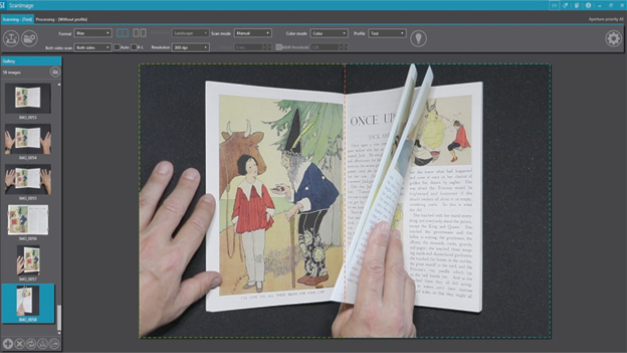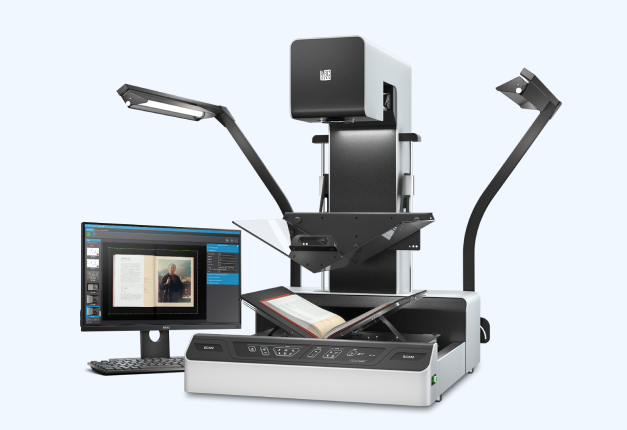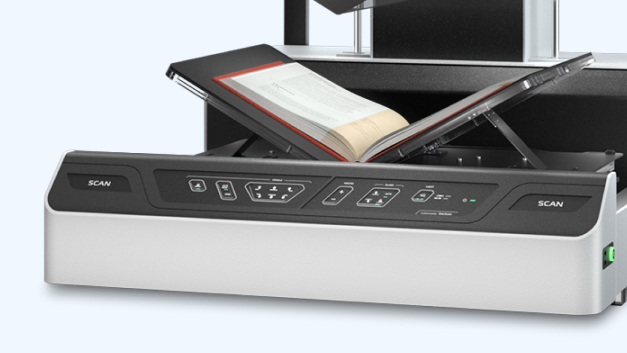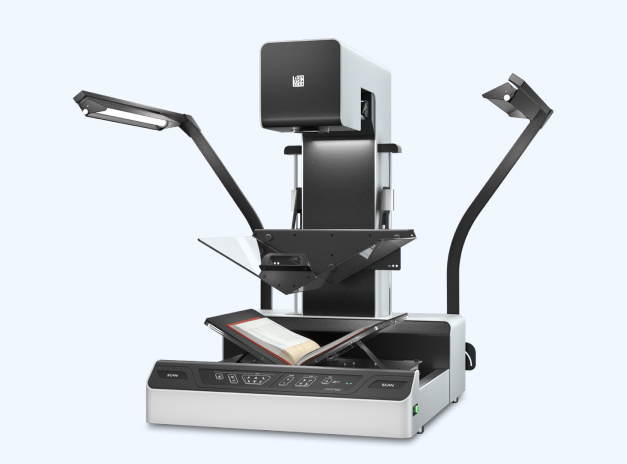What «ElarScan» is?
«..But to make it clear for everybody, we define ElarScan very simply as: «it is a book- (or a bound file-) archive/library professional contactless scanner for digitization of all types of documents, for digital governmental services, for equipping modern corporate offices and document processing centers, for scanning at municipal and financial institutions, at pharmaceutical companies and for registration services..»
— marketing department mantra!

«The same as everybody uses» — good. But not always
We live in the world of stereotypes and mass standards. No need to ask — which movie is the most popular now, what pants are the most fashionable, and which model of kettle to buy — all this is written on every fence, web-page, tv-screen or social media. This can be quite convenient: it saves us time when selecting the model of an iron or a car: the first option is already clear, and it is possible that it is not bad, or even quite suitable. Of course, this is OK for when you look for a consumer product. But it is not like this in the sphere of professional solutions or equipment.

What is ElarScan?
Everyone understands that cameras within trendy smartphones work perfectly for household tasks like «this is my receipt I do not want to lose», however they are not suitable for routine digitization and electronic storage of client’s files at the bank. ElarScans are"planetary" document scanners, which are made for bound and «difficult» documents: to scan files and folders at an office, at administrative departments, at document processing centers. They are called also book-scanners, «face-up», «over-head» (like a projector), and even «photographic scanners». ElarScan is a desktop device for convenient digitizing of difficult documents or objects — not necessarily books or papers: there can be medals and coins, samples of fabrics and some accessories, any articles and artifacts, etc. It delivers the important outcome of productive continuous operation: «to see what you’re scanning and not flip upside-down for turning a page» — in contrast to flatbed scanners or Multi-Function Products. ElarScan immediately delivers high quality images and saves the files in the correct format.
What else is required?
High performance: Ergonomic and comfortable operation, the scan time must be less than the time to turn a page — no more than a couple of seconds. Well, versatility: a large maximum format is needed — up to A2 (approx 40×60 cm). For flat maps or drawings it should accommodate flat placement of the target material (cradle), but if next you have a hard to open folder or a book — the cradle must adjust to a V-shape placeholder with an adjusted angle. If we need to see the details of fine texture or the smallest details of a museum artifact, an ancient record — then we can gradually focus into the image by incremental steps by pressing our «macroscan» button.
Why do we say book scanner?
The term is historical: before «copy stands» (whose design and principle of operation were very similar to old photographic enlargers, printing photos from negatives and slides), were used for the digitization of valuable old books like Gutenberg’s Bible. Powerful digital cameras did not exist, and instead of film in copy stand’s photo-cameras, a special electro-mechanical «digital scanning back» was used. Back in the early 1990s, scanning backs for cameras already provided a super-high resolution of 100 megapixels per frame and even higher. Of course, first scanning backs needed minutes to create one picture, so the scene and camera must be absolutely static. In the late 1990s manufacturers of planetary scanners replaced these hybrid photo-cameras with specially designed «heads», using moveable linear photo-detectors. Dramatically progressing professional matrix photo cameras, achieving higher and higher resolution at more and more affordable prices and now positioning themselves attractively for document scanning.«Book scanner» ElarScan, utilising modern high quality smart cameras, is clear evidence of this.

Not only books!
But today we have to specifically explain that a «book scanner» is not only for books and libraries. The term «planetary scanner» is more correct, but is typically hard to understand. ElarScan is also «an overhead scanner» (like an overhead projector), there are «document cameras» and all kinds of «non-contact image capture devices» appearing: now even experts do not understand what is what. An additional problem is that digitization (in general) and contactless ElarScans, non-feeding and not-flatbed scanning penetrate more and more into very different spheres of our lives — every industry adopts new terminology! For offices and museums, libraries and banks, processing cadastral plans and studying court cases — specialists talk different languages and terms. It is not easy to understand each other nor to formulate which product or solution is best suited to each task.
You can not just write «the best scanner»
Of course, ElarScan is not always the only solution. There are always options. You can order a digitizing service from a skilled company — a copy center, a service bureau, a scan-center. Let them buy book scanners themselves, and provide you with ready for use scanned copies, electronic resources, collections, selections without creating your own internal scan service division. If the digitizing task is not very important — no personal data or copyrights — you can even attempt to use students with smartphone cameras — and see what will happen (not recommended btw). As a final option, you can get ill, forget about the task or even quit your job — but such solutions are also not recommended. But if you really need to scan bound or difficult documents, ElarScan is most probably the most versatile and convenient solution, at the top — it is relatively inexpensive and is being rapidly adopted everywhere. Please contact us: we will provide a demonstration and explain more.

If it is so easy, why elarscans are not used everywhere?
It is not about popular everyday usage, but about professional services and solutions, about more and more important issues of saving digitizing costs, increase an efficiency of document processing at offices and institutions, to transfer business processes to electronic rails. ElarScans digitize test protocol books for new medicines at pharmacy. For It is not about popular everyday usage, but about professional services and solutions, about more and more important issues of saving digitizing costs, increase an efficiency of document processing at offices and institutions, to transfer business processes to electronic rails. ElarScans digitize test protocol books for new medicines at pharmacy. For visitors at municipal archives it is now convenient to copy the paper records: people do it themselves, scanning directly to personal accounts at public portals — using ElarScans connected to the Internet running at reading rooms. Why such a useful and simple self-service is not known everywhere? Just the tasks of digitizing for every professional area differs, specialists use other terms for task description, even the same types of digitizing devices are calling differently! There are now very new general challenges and trends appearing: «digitization of business», «digital government», «digitized public services», and many others. What to look for, which keywords to use in order to find ElarScans and best proven digitizing practices? Should ElarScans be really called in other way — closer to their real applications and exact professional communities, means — more «user-oriented»?
ElarScans at libraries and universities
During the three years that have passed from the first pilot installations, more than a hundred of ElarScans began to work at large and small organizations. Of course, the main applications are at public and university libraries. At universities ElarScans are used to digitise text, doctorate and reference books, providing content for e-learning courses, replace copiers, turning to paperless education — it is better to call them not just a «book-», but a «university-scanner», or a «student’s scanner»! University, public, municipal libraries digitize journal articles and book chapters at the request of researchers and readers. Municipalities and Local Governments use ElarScans to digitise record books, utility maps and journals for easy access online. More and more ElarScans work for self-scanning: a special simplified user interface does not require scanning skills of the visitor to make an electronic copy of pages to flash drive (or to an internet cloud): this is like a «library scanner» or a «self-scanner».
Experts say that self-scanning or «walk-up library scanning» (how they call it) in most cases is used not for books, but for digitizing periodicals, including scientific articles. So ElarScan at public and research libraries it is not just a book, but a «magazine scanner». Having maximum format of A2, ElarScan works as a perfect «newspaper scanner». At the corporate and special libraries, collecting scientific and technical information it should be called a «scanner of R&D reports».

Scanner for public and municipal services
Public officers often say: «There are a lot of important records at our archives, but knowing our overload and long processing time people do not like to request the documents. It is clear that should we publish the digitized content or even just disclose full catalogues of our records, the number of users would increase by hundreds of times!» The quantity of ElarScans at public services is increasing, and not only at central archives. Among the users now are more and more small archives, municipal public services, information departments servicing citizens.
One of the most important ElarScan applications is to scan paper registers and personal act books at the responsible departments of public offices. Digitization of real estate files, archives of land property acts, which include hard to handle large format plans, drawings, maps are the favorite applications of contactless planetary scanners. Book scanners are increasingly used for digitization of documents upon request of the citizen: it has become easier to get an electronic copy, reducing the need to visit the organization.
Digitization for archives and museums
«Archive scanners» and «museum scanners» more often are ultra high resolution scan equipment of very large format, compliant with the specific international requirements for «digitization of national heritage». Being more simple ElarScan is more a «workhorse of digitization», working much faster and easier it does not require professional operators, and — which is important — costs several times less. Digitization of archive catalogues at state and municipal, special and research archives is one of the oldest and still relevant tasks for contactless planetary scanners. At museums it is the similar classic application — digitizing of inventory books to fill up a museum information systems, providing revisions of holdings, proper management and safeguarding of museum collections. At the same time, contactless ElarScans are professional assistants for creating digital collections of any «inconvenient to scan» small and midsize museum items including coins, medals, cutlery, handworks, etc. Special benefits of ElarScan here are fast single-shot digitizing (not sensitive to slow movement of object) and macroscan feature: to enlarge a small item while scanning by just pressing one button. Unique «manuscript» models of ElarScan with extra large motorized cradles allow scanning of extra thick volumes: historical archives keep old parish and census registers of half a meter thick and even thicker.
How to call ElarScan at banks?
Usual meaning of a «bank scanner» is far from document digitizing — it is perhaps a kind of banknote checker or security x-raying gates at the bank’s entrance. But what is a «scanner of client’s dossiers» or «financial report digitizer» if it is not an ElarScan? Manufacturers tried to call it a «dossier-scanner», but it is hard to pronounce. Quite a new term of «planscan» (from «planetary scanner») sounds sharp still, but used more and more often — it is not as difficult to say as the volcano «Eyjafjallajökull» in Iceland.
Playing by the rules
There are more and more ElarScan users at financial and juridicial spheres where regulations do not allow the unbinding of volumes or stitched files. Balance sheets and accounting reports are classic digitizing tasks of our «accountant’s scanner». Planetary scanners work at arbitrary and general courts as «scanner of court cases», providing access to documents without tedious and expensive paper copying. Client dossiers and files at insurance or juridicial institutions are relatively new, but already important tasks for ElarScans. In general, to digitize documents without breaking the rules for their retention and handling is a key feature of ElarScan, so these kinds of regulations executor should be called a «compliant digitizer» or just «a fair play scanner».
